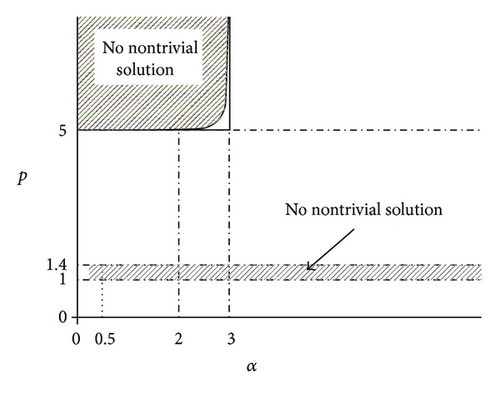Nonexistence Results for the Schrödinger-Poisson Equations with Spherical and Cylindrical Potentials in ℝ3
Abstract
We study the following Schrödinger-Poisson system: −Δu + V(x)u + ϕu = |u|p−1u, −Δϕ = u2, lim|x|→+∞ϕ(x) = 0, where u, ϕ : ℝ3 → ℝ are positive radial functions, p ∈ (1, +∞), x = (x1, x2, x3) ∈ ℝ3, and V(x) is allowed to take two different forms including and with α > 0. Two theorems for nonexistence of nontrivial solutions are established, giving two regions on the α − p plane where the system has no nontrivial solutions.
1. Introduction
The above system was introduced in [1] in the study of an N-body quantum problem, that is, the Hartree-Fock system, Kohn-Sham system and, so forth [1–4]. For V(x) in the form of a constant potential, the nonexistence of nontrivial solutions of (1) for p ∉ (1,5) was proved in [5] by using a Pohožaev-type identity. For V(x) in the form of the singular potentials as considered in this work, existence of positive solutions has been established under certain assumption [6]. However, the conditions under which nontrivial solutions do not exist have not yet been full established. Hence, in this paper, we study the nonexistence of solutions to the problem (1) with singular potential.
The main contribution of this work is the development of analytical results giving two regions on the α − p plane where the system (1) has no nontrivial solutions. The two α − p regions are shown in Figure 1. The rest of the paper is organized as follows. In Section 2, we first give some basic definitions and concepts and then, based on the method in Badiale et al. [7], establish a Pohožaev-type identity. In Section 3, we give two theorems summarizing the nonexistence results we obtained and then prove the theorems.

2. Preliminaries and a Pohožaev-Type Identity
Definition 1. For i = 1 or 2, if (u, ϕ) ∈ L2∩Lp+1∩Ei∩C2(ℝ3∖{ri = 0}) × D1,2∩C2(ℝ3∖{ri = 0}) satisfies
3. Nonexistence Results for the System of Pohožaev-Type Identity Equations
The nonexistence results we obtained for system (1) are summarized in the following two theorems.
Theorem 2. For x = (x1, x2, x3) ∈ ℝ3 and , if α ∈ (0,3) and p ∈ (1, min {7/5, (3 + α)/(3 − α)})∪[max {5, (3 + α)/(3 − α)}, +∞), or α ∈ [3, ∞) and p ∈ (1,7/5], any solution (u, ϕ) of problem (1) is trivial.
Proof of Theorem 2. Let ∞ > R2 > R1 > 0, BR = {x ∈ ℝ3, |x| < R}, , and ; we then have . Since u ∈ E1∩Lp+1, ϕ ∈ D1,2, we have
Let . Similar to Theorem 2, we get another nonexistence result to the system (1) with potential function .
Theorem 3. For x = (x1, x2, x3) ∈ ℝ3 and , if α ∈ (0,3) and p ∈ (1, min {7/5, (3 + α)/(3 − α)})∪[max {5, (3 + α)/(3 − α)}, +∞), or α ∈ [3, ∞) and p ∈ (1,7/5], any solution (u, ϕ) of problem (1) with is trivial.
Proof of Theorem 3. For any R2 > R1 > 0, setting , then , where and ν(x) = (−x1/R1, −x2/R1, 0) on . Note that
4. Conclusion
We mainly study the nonexistence of nontrivial solutions to system (1) in this paper, giving two regions on the α − p plane where the system (1) has no nontrivial solutions; see Figure 1. In another paper, we will study the existence of nontrivial solutions to system (1).
Acknowledgments
This research was supported by the National Science Foundation of China (NSFC)(11201486), the Chinese National Social Science Foundation (10BJY104) and the Fundamental Research Funds for Central Universities (31541311208). B. Wiwatanapataphee gratefully acknowledges the support of the Faculty of Science, Mahidol University.




